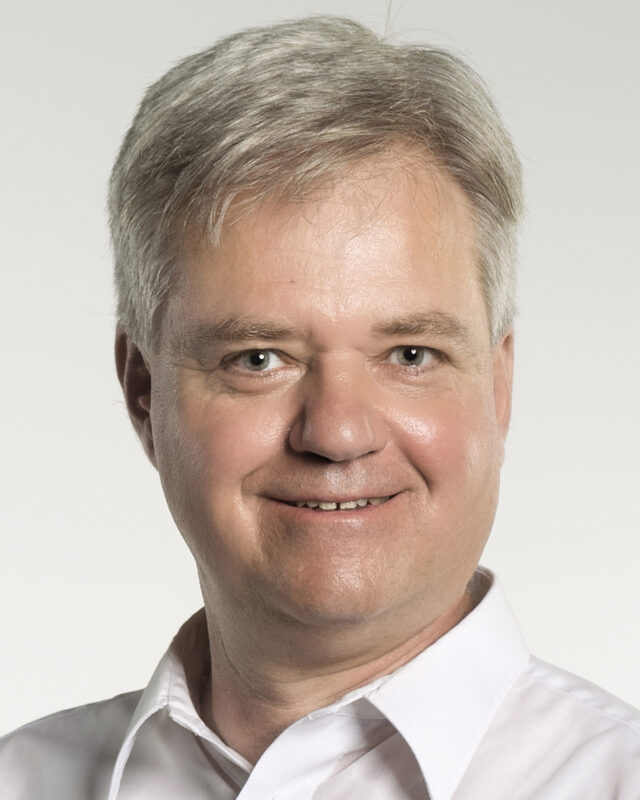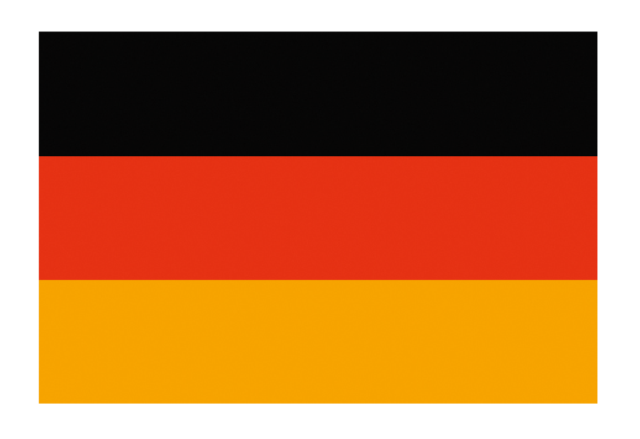Agile development is the answer to the fast changing customer demands, which are resulting from the current predominant mega trends. Agility in this context means the quick and ideally tailored answer to market and customer demands. As an example, recently strong changes to our product portfolio are arising for KAMAX from the changing market demands driven by the mega trends neo-ecology and mobility. The fasteners typically used in today’s combustion engines will fade out in the future and new solutions and products will arise from e-mobility or fuel cell technology.
In June 2020 a new small department named “Innovation Hub” was established within KAMAX Technology with the task to identify such new product fields for KAMAX and evaluate their feasibility and their fit to our strategy.
For being able to quickly react to the fast changing market demands the Innovation Hub employs agile development methods, because the traditionally used stage-gate-development processes would be to static and slow in response. Agile development methods arouse in the 1980s as an alternative to the stage-gate-development process. Although initially mostly applied in software development, agile development can also be successfully applied to the development of hard ware. A here widely used method is SCRUM – also adopted at the Innovation Hub.
The term SCRUM originates from a move in rugby sports where it describes the restart of the game with all players of both teams positioned head to head and trying to get hold of the ball by jointly pushing the opponent players away from it. Therefore, it’s a metaphor for a joint effort of a team to reach their goals.
But where is the difference to the traditional stage-gate-process and what makes the SCRUM development process agile? The answer lays within the difference in execution of project steps. The stage-gate-process, which is also called “waterfall”-development process, is a linear process where the next step is only beginning when the previous step is completed and released.
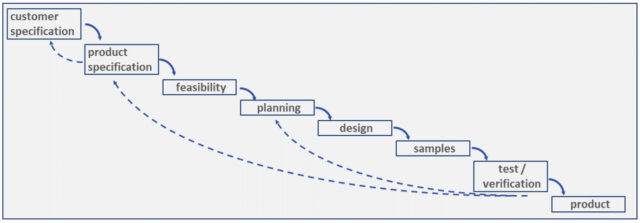
*Stage Gate (water fall) development process
At the beginning of the stage-gate-process a product specification is mutually agreed between the customer and the product developer. This specification remains valid and unchanged throughout the complete development process, at least until the conclusion of the verification stage. It becomes clear that if the verification does not meet the specification demands either the product specification must be changed or a loop back to the planning stage with a revised design must be taken. However, at this stage already a lot of time and resources have been used.
Agile development on the contrary has a different approach to overcome this inflexibility of a stage-gate-process. For one thing, SCRUM does not plan the content of each project step in a comprehensive way from the beginning to the end, but divides the work into many small work packages, which are called “sprints”. Typically a sprint in SCRUM lasts a few days to a few weeks. Thus, results become available in short time and may then be evaluated and used for planning the next sprints.
Secondly, SCRUM does not work with a fixed and constant specification comprising the complete project scope at once. It rather develops the product specification, which is then called product backlog, making use of the available sprint results to plan the next sprints and align the product backlog with the stakeholders. Of course, there is also an initial definition of what the stakeholders wish to receive as a result of the development. But this so called user story is rather widely defined leaving room to adapt the solution to the needs of the stake holder. In SCRUM, a user story can comprise a large project lasting even years and consisting of many sprints. But it can also be confined to a specific question, which may last only a few sprints. Fig. 2 illustrates the SCRUM process, also showing the different roles of people involved.
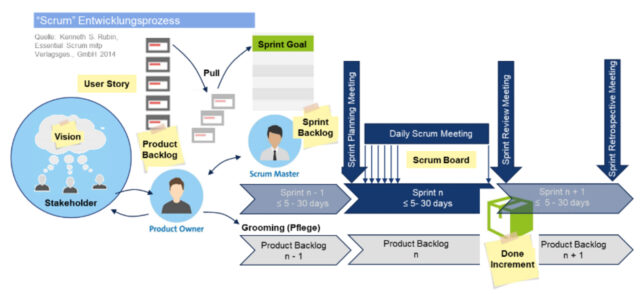
*SCRUM development process
The main two reasons why the SCRUM process is flexible in producing the best fitting solution to the stakeholders needs are: the division of the project scope in many sprint units and the feedback to the product specification at a very early stage according to the sprint results.
To make the SCRUM development process a success, different people with different roles in the process must work together. The SCRUM roles are illustrated in Fig. 3.
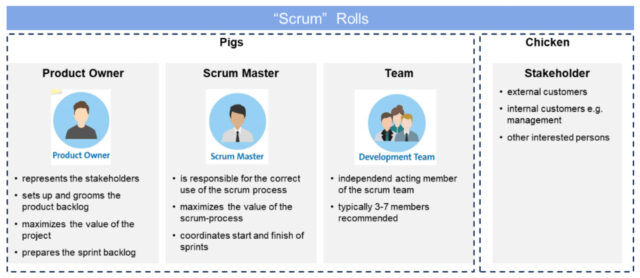
*SCRUM roles
The SCRUM concept has a clear view on the participating parties with respect to their commitment or involvement. This is nicely illustrated by the pig and the chicken fable often cited in SCRUM. The story goes like this: A Pig and a Chicken are walking down the road. The Chicken says: “Hey Pig, I was thinking we should open a restaurant!” The pig replies: “Hm, maybe. But what would we call it?” The Chicken responds: “How about ‘ham & eggs’?” The Pig thinks for a moment and says: “No thanks. Because then I’d be committed, but you’d only be involved.”
This little story may help to understand how tasks, responsibilities and rights of the different roles are assigned to the participating parties in SCRUM.
A very crucial role holds the product owner. He has the responsibility to communicate the stakeholder needs to the SCRUM team by setting up the product backlog and sprint planning. Yet he also reports back the sprint results yielded by the SCRUM team to the stakeholders and thus optimizes the product specification, i.e. product backlog. The SCRUM master leads the SCRUM team, is part of the sprint planning and he coordinates the work in the sprint. At KAMAX the SCRUM team consists of employees from Innovation Hub (TIH) but is also enforced by external members from other TEC-departments or even from outside TEC. Through this, an interdisciplinary team can be setup in reference to the content needs of each sprint. According to the philosophy of involved and committed parties, during a sprint the SCRUM team is working independently and without interference from outside. By this, the SCRUM team is totally focused on the sprint content and can work out creative solutions to its tasks. After each sprint, the achieved results (called sprint increments) are communicated to the product owner.
New product ideas, no matter where they come from, are worked out by the Innovation Hub in four steps, which we denote as level of elaboration or short, LoE1, LoE2, LoE3, LoE4. In the first step (LoE1) the registration of the idea into a database (JIRA) is done. In the second step (LoE2) the idea is described in greater detail by interviewing the initiator of the idea or a first short research. These two steps are not yet time consuming and need only a few minutes. Based on these information sprints the next steps are planned to further work out the idea. The sprint for LoE3 typically requires one to two days and produces solution ideas, technical feasibility and an estimated market assessment. Finished LoE3 ideas are then presented to a steering committee and if rated with high priority the next sprints for working out LoE4-level are planned. This phase is the most time consuming and may comprise several weeks to a few months. The results of a LoE4 phase are the proof of concept of the proposed idea solution, the evaluation of the necessary technologies with respect to the KAMAX technological fit, as well as an evaluation of the market chances, which are worked out in close cooperation with Business Development and Sales.
After a successful completion of LoE4 sprints the product or process development ideas are again presented to the steering committee and, if rated with high priority, forwarded to the following development departments TPD and TPA for further development into serial application.
With this procedure, Innovation Hub has registered more than 200 development ideas and completed 32 ideas with status LoE3 until today. Two development ideas have been successfully worked out to status of LoE4.
As an example of a LoE4 development idea the analysis and identification of future products, resulting from the emerging hydrogen-economy, may be stated. In this project not only products in the field of hydrogen driven vehicles (fuel cells) were analyzed, but also non-automotive applications in the area of the production or distribution of hydrogen or energy production by stationary fuel cells were evaluated.
With the implementation of an agile development team in the Innovation Hub, KAMAX has installed the necessary tools to quickly find answers to the changing demands in our markets and make these product ideas ready to develop them into future serial application.
KONTAKT
KXpress · 2021 | 01
